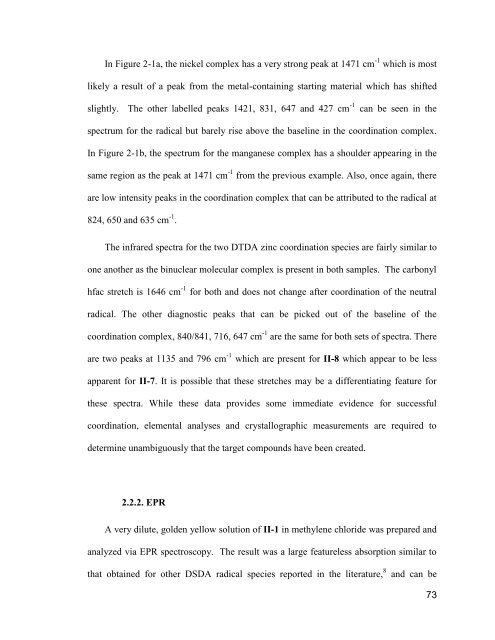1,2,3-Dithiazolyl and 1,2,35-Dithiadiazolyl Radicals as Spin-Bearing ...
1,2,3-Dithiazolyl and 1,2,35-Dithiadiazolyl Radicals as Spin-Bearing ...
1,2,3-Dithiazolyl and 1,2,35-Dithiadiazolyl Radicals as Spin-Bearing ...
You also want an ePaper? Increase the reach of your titles
YUMPU automatically turns print PDFs into web optimized ePapers that Google loves.
In Figure 2-1a, the nickel complex h<strong>as</strong> a very strong peak at 1471 cm -1 which is most<br />
likely a result of a peak from the metal-containing starting material which h<strong>as</strong> shifted<br />
slightly. The other labelled peaks 1421, 831, 647 <strong>and</strong> 427 cm -1 can be seen in the<br />
spectrum for the radical but barely rise above the b<strong>as</strong>eline in the coordination complex.<br />
In Figure 2-1b, the spectrum for the manganese complex h<strong>as</strong> a shoulder appearing in the<br />
same region <strong>as</strong> the peak at 1471 cm -1 from the previous example. Also, once again, there<br />
are low intensity peaks in the coordination complex that can be attributed to the radical at<br />
824, 650 <strong>and</strong> 6<strong>35</strong> cm -1 .<br />
The infrared spectra for the two DTDA zinc coordination species are fairly similar to<br />
one another <strong>as</strong> the binuclear molecular complex is present in both samples. The carbonyl<br />
hfac stretch is 1646 cm -1 for both <strong>and</strong> does not change after coordination of the neutral<br />
radical. The other diagnostic peaks that can be picked out of the b<strong>as</strong>eline of the<br />
coordination complex, 840/841, 716, 647 cm -1 are the same for both sets of spectra. There<br />
are two peaks at 11<strong>35</strong> <strong>and</strong> 796 cm -1 which are present for II-8 which appear to be less<br />
apparent for II-7. It is possible that these stretches may be a differentiating feature for<br />
these spectra. While these data provides some immediate evidence for successful<br />
coordination, elemental analyses <strong>and</strong> crystallographic me<strong>as</strong>urements are required to<br />
determine unambiguously that the target compounds have been created.<br />
2.2.2. EPR<br />
A very dilute, golden yellow solution of II-1 in methylene chloride w<strong>as</strong> prepared <strong>and</strong><br />
analyzed via EPR spectroscopy. The result w<strong>as</strong> a large featureless absorption similar to<br />
that obtained for other DSDA radical species reported in the literature, 8 <strong>and</strong> can be<br />
73

















